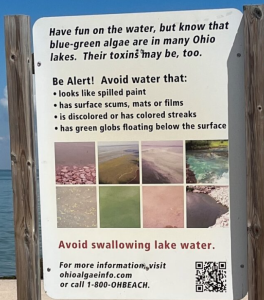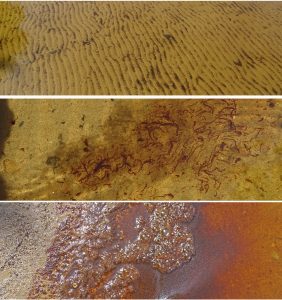 The Killing of Lake Erie and Discovering Right Relationship Ten Years Later
The Killing of Lake Erie and Discovering Right Relationship Ten Years Later
By Tish O’Dell on www.celdf.org, Aug 6, 2024. “…With LEBOR ]Lake Erie Bill of Rights] stripped from the options for curtailing Lake Erie’s ongoing assassination, the algae persists, effectively unstoppable. “We know how to predict the blooms. We know how to track them,” says Tom Bridgeman, director of the Lake Erie Center at the University of Toledo. “We know how to provide early warning to the water plants. The water plants know how to handle the blooms … but we haven’t made a lot of progress in preventing them in the first place.” “We do have a lake water problem, and it’s worse than it was 10 years ago today,…”
Blue-Green and Benthic: A Workshop on Monitoring, Mitigation and Management of Cyanobacteria in Atlantic Canada. Final Report.
Hiscock, A et al., 2023. A Workshop on Monitoring, Mitigation, and Management of Cyanobacteria in Atlantic Canada, Final Report. http://hdl.handle.net/10222/82236. Available on Dalspace
WORKSHOP SUMMARY Since the 2018 Atlantic Canadian Cyanobacteria Workshop, we have seen a rapid increase in the number of waterbodies (recreational and drinking water supplies) under public advisories, exposing gaps in local capacity for surveillance, notification, and mitigation. The aim of this workshop was to disseminate local expertise, promote the coordination of research programs between participants, and inform future monitoring strategies and areas of research. The workshop provided a forum for academic, government, and industrial researchers to connect with regulators, operators, and practitioners and share novel findings and on-going research into benthic and planktonic proliferations of cyanobacteria across Atlantic Canada. This report contains key findings from the workshop, challenges related to the complexity of cyanobacteria, and outstanding research questions that should be addressed in future efforts.
| Harmful Algae Blooms Page on halifax.ca
In 2020: |
 2019 bloom on Sandy Lake 2019 bloom on Sandy Lake– Sandy Lake inundated by unpleasant, suspended, reddish, soapy material Aug 6, 2019; and lake level falling quickly Post Aug 7, 2019- Advisory issued for Sandy Lake due to possible blue-green algae bloom Aug 7, 2019 Post Aug 7, 2019- Water quality issue at Sandy Lake Bedford has subsided (Aug 9, 2019) Post, Aug 9, 2019 |
Field guide to algae and other “scums” in ponds, lakes, streams and rivers
Miriam Steinitz Kannan and Nicole Lenca, Northern Kentucky University 2013
| Cyanobacteria Presence in Four Lakes in the Halifax Regional Municipality (HRM), Nova Scotia Betts, Rebecca A. Dalhousie University Graduate thesis 2018. “The major objective of this project is to assess the presence of cyanobacteria (organisms that can pose serious challenges for drinking water treatment systems), in Halifax water supplies using DNA typing to identify cyanobacteria species. Four lakes in the Halifax Regional Municipality (HRM), NS, were chosen due to their differing water chemistry. A total of 35 taxa of cyanobacteria and one taxa of unassigned bacteria were detected, of which, 15 genera of cyanobacteria were identified. Of those genera, 11 have been associated with cyanotoxins, which are harmful to humans and animals. Supplementary data showed that two of the four lakes had higher pH, alkalinity, TN, TP and turbidity means than the others, and had detectable cyanotoxins and algal blooms after periods of rain followed by long periods of warm, dry, relatively calm weather. This thesis will provide a foundation for future experiments into lake and cyanotoxin management.”Some extracts from lit review 1.3. FACTORS THAT INFLUENCE BLOOMS 1.3.1. Eutrophication Eutrophication in lakes occurs when excessive amounts of nutrients, in particular nitrogen (N) and phosphorus (P), are added to the water system from sources such as fertilizer run off, manure, and sewage (Paerl et al, 2015, 2016; Schindler et al, 2016). Lakes where phosphorus is high in ratio to other nutrients such as carbon and nitrogen, tend to be more favourable environments for cyanobacteria growth (Schindler et al, 2016; Verhamme et al, 2016; Lin et al, 2017).1.3.2. Climate Change and Lake Recovery from Acidification Rising temperatures and longer seasons caused by climate change results in higher temperatures and prolonged thermal stratification within lakes, preferred growth conditions for cyanobacteria (Whitton and Potts, 2000; Pick, 2016). Drought conditions can also be beneficial to cyanobacteria if periods of intense rainfall occurred prior to the drought, which would affect nutrient flow into watersheds and prolong stratification in lakes (Paerl et al, 2016; Pick, 2016).Another factor influencing the rise in algal and cyanobacteria blooms could also lie in the process of lake recovery from acidification.In Nova Scotia, lakes are typically acidic due to naturally occurring organic acids and bedrock geology, whereby silica-based gneiss and granite are acid sensitive due to limited carbonate sources and low base cation concentrations (Jeffries et al, 2003b; Ginn et al, 2015). Lake pH has been further depressed by long-range transport of sulphate(SO42-) from industrial centers in northeastern United States, the Laurentian Great lakes Area and local oil refineries and power generating stations, as well as by natural acidification from organic anions (Ginn et al, 2015).According to studies performed during the 1990’s, there were no trends showing lake recovery from acidification in lakes in Nova Scotia (Jeffries et al, 2003a). However, according to Anderson et al (2017), several drinking water supplies in Nova Scotia have been showing signs of lake recovery in recent years.Lake recovery from acidification could potentially mean the return of fish populations to water bodies, and the increase of cyanobacteria activity, as the chemical and biological effects of acidification are decreased (Jeffries et al 2003a,b).1.4. ALGAL BLOOMS IN NOVA SCOTIA As mentioned previously, lakes in Nova Scotia are typically acidic due to naturally occurring organic acids and bedrock geology (Jeffries et al, 2003b; Ginn et al, 2015). However, due to influencing factors like eutrophication from mink farms, climate change, and potential lake recovery from acidification, blooms, even toxic blooms caused by cyanobacteria, have not been unusual to the province within the last decade (Whitton and Potts, 2000; Taylor, 2009; Brylinsky, 2011; Pick, 2016; Anderson et al, 2017).Mattatall Lake, shared between Colchester County and Cumberland County has experienced algal blooms since 2005 (Mathieson, 2015; Campbell, 2016; Tetanish, 2016). It has also been reported that these blooms can persist into November or even January. However, in 2017, there was no bloom observed at Mattatall Lake (Sullivan, 2017). Locals observed that unlike in previous years, the lake was clear, vegetation had begun to grow on the bottom of the lake, and a species of frog had returned. Yarmouth County and Digby County have experienced algal blooms every year since 2007 (Province of Nova Scotia (PNS), 2007, 2016f; Wendland, 2011; Lavoie, 2014; Allen, 2016). Of note, blooms have been observed in Lake Fanning, Parr Lake, Ogden Lake and Lake Vaughan in Yarmouth County, and Porcupine Lake in Digby County.Other areas of note include Inverness County, where Lake Ainslie has had algal blooms in 2009 and 2010, and both the Southwest Margaree River and Margaree River have exhibited blooms in 2009 (PNS, 2009a,b, 2010). Lochaber Lake, located in both Antigonish County and Guysborogh County, experienced an algal bloom in 2012 (Lochaber Community Development Association, 2012). In Kings County, Lumsden Pond in the Lumsden Pond Provincial Park in Wolfville was reported to have algal blooms in 2013 and 2016, while Lake Torment has experienced blooms since at least 2014 (PNS, 2013b, 2014, 2015, 2016b,d; Tetanish, 2016). In 2015, an algal bloom was reported in Sherbrooke Lake in Lunenburg County, and in 2016 an algal bloom was reported in Middle River in Pictou County (PNS, 2016e; Tetanish, 2016).Algal blooms have even been reported in Halifax County, albeit only in recent years. Algal blooms were reported at Powder Mill Lake in Waverley in 2016, and in Oathill Lake in Dartmouth in 2017 (PNS, 2016c; Meloney, 2017). However, the bloom in Oathill Lake was determined to be a green algae bloom, and was not definitively associated with cyanobacteria. |
Exploring temperature and precipitation impacts on harmful algal blooms across continental U.S. lakes
Ho and Michalak, 2019. Limnology & Oceanography “We find evidence in support of the hypotheses that summer temperatures drive total abundance, that the length of the summer drives cyanobacterial abundance, and that increased temperatures may reduce the observed toxicity of blooms in some cases. We find that nutrient concentrations are also likely to be impacted by lake warming, as increased temperatures are robustly associated with increased total phosphorus concentrations. Evidence for the impact of precipitation is mixed”
Urban Lakes Management Planning
Presentation to Harbour East Marine Drive Community Council, October 4, 2018 by Oathill Lake Conservation Society
Ecosystem revival set back by unexpected algae bloom in Dartmouth lake
Nic Meloney · CBC News · Posted: Oct 09, 2017 “Conservation group has noticed irregular amount of green algae collecting on surface of Oathill Lake”
Community calls for fix to algal blooms, weeds and bacteria in Dartmouth lakes
By Taryn GrantStar Halifax Fri., Aug. 23, 2019
Dartmouth. Lakes Town Hall
Thursday, August 22nd, 2019 MicMac Amateur Aquati c Club, Dartmouth, Nova Scotia
Oathill Lake Restoration
Slideset Dec 19, 2014
Blue Green Algae: The Good, The Bad and The Ugly
Elisabeth Favot PH.D gave an illustrated talk about Cyanobacteria in Ontario freshwater lakes with additional input from Professor Barb Elliot and Norman Yan. Discusses climate change and BGA blooms, the need to keep lakes as close to their pristine condition as possible.
Climate variability promotes unprecedented cyanobacterial blooms in a remote, oligotrophic Ontario lake: evidence from paleolimnology
Elizabeth J. Favot ey al., 2019. J Paleolimnol (2019) 62:31–52 “Abstract Dickson Lake, located in Algonquin Provincial Park, Ontario, is a remote, oligotrophic lake, where cyanobacterial blooms of the genus
Dolichospermum (Ralfs ex Bornet & Flahault) P. Wacklin, L. Hoffmann and J. Koma´rek were reported for the first time in the fall of 2014, and subsequently in the late spring of 2015. To investigate the potential environmental triggers of these bloom events, we assessed long-term trends in water quality using a multi-proxy paleolimnological approach, examining sedimentary diatoms, chironomids, cladocerans, spectrally inferred chlorophyll a, and cyanobacterial akinetes preserved in a 210Pb-dated sediment core…These paleolimnological findings corroborate observed reports of the onset of cyanobacterial blooms in Dickson Lake in late 2014 and are consistent with increasingly favourable bloom-forming conditions over the past few decades that are related to warmer air temperatures, sharp declines in wind speed, and a lengthening of the ice-free season by 2 weeks since 1975. It is plausible that late ice-out and a quick onset. PDF available
Investigating Long-term Environmental Trends in Central Ontario Lakes Impacted by Cyanobacterial Blooms
L Favot – 2021 PhD thesis, Queens University. “Collectively, increasing primary production tracked over the last several decades (without parallel increases in nutrient enrichment) across all study lakes has likely occurred due to regional warming and a longer ice-free growing season, and invokes climate change as an important driver of cyanobacterial blooms in temperate lakes. PDF available
